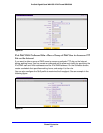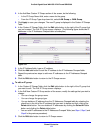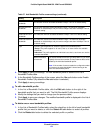
Firewall Protection
172
ProSafe Gigabit Quad WAN SSL VPN Firewall SRX5308
Note: A schedule narrows down the period during which a firewall rule is
applied. For information about specifying schedules, see
Set a
Schedule to Block or Allow Specific Traffic on page 185.
Add Customized Services
Services are functions performed by server computers at the request of client computers. You
can configure up to 124 custom services.
For example, web servers serve web pages, time serve
rs serve time and date information,
and game hosts serve data about other players’ moves. When a computer on the Internet
sends a request for service to a server computer, the requested service is identified by a
service or port number. This number appears as the destination port number in the
transmitted IP packets. For example, a packet that is sent with destination port number 80 is
an HTTP (web server) request.
The service numbers for many common protocols are defined by the Internet Engineering
T
ask Force (IETF) and published in RFC 1700, Assig
ned Numbers. Service numbers for
other applications are typically chosen from the range 1024 to 65535 by the authors of the
application. However, on the VPN firewall you can select service numbers in the range from 1
to 65535.
Although the VPN firewall already holds a list of many service port numbers, you are not
limite
d to these choices. Use the Services screen to add additional services and applications
to the list for use in defining firewall rules. The Services screen shows a list of services that
you have defined, as shown in the following figure.
To define a new service, you need to determine first which port number or range of numbers
is use
d by the application. You can usually determine this information by contacting the
publisher of the application, user groups, or newsgroups. When you have the port number
information, you can enter it on the Services screen.
To add a customized service:
1. Select Security > Service
s. The Services screen displays. The Custom Services table
shows the user-defined services. (The following figure shows some examples.)


















